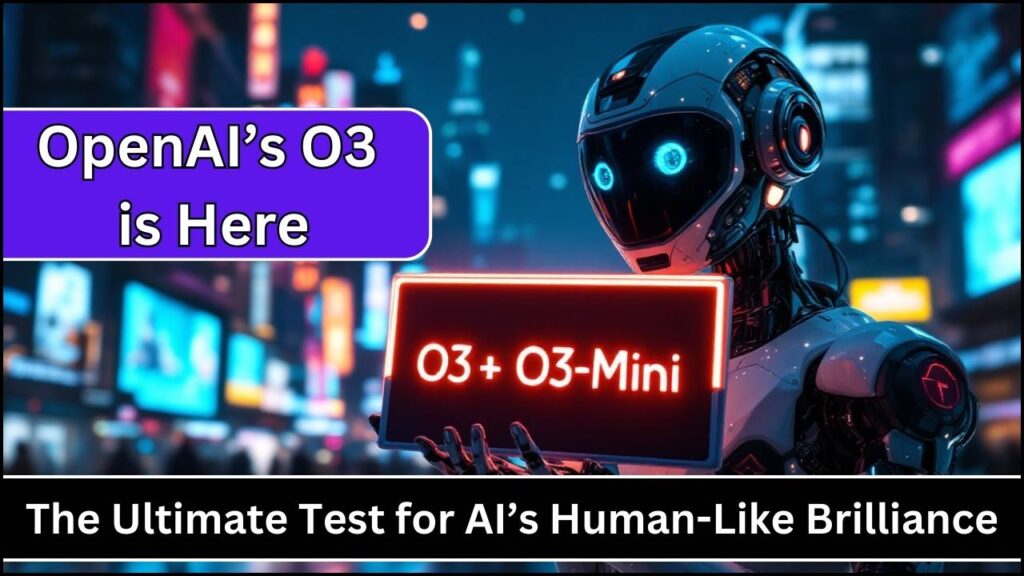
OpenAI’s O3: Artificial Intelligence (AI) has been evolving at an incredible pace, and OpenAI’s latest innovation, the O3 model, marks a groundbreaking moment in this journey. Designed to exhibit human-like reasoning and problem-solving capabilities, O3 is not just an incremental update but a leap toward more intelligent, reliable, and ethical AI systems. With this model, OpenAI aims to set new standards in AI functionality, redefining how humans and machines collaborate to solve problems.
In this article, we’ll explore what makes O3 revolutionary, how it performs across various benchmarks, and what it means for industries, researchers, and the future of AI. Additionally, we’ll discuss its potential applications, challenges, and the roadmap for public adoption.
OpenAI’s O3
| Feature | Details |
|---|---|
| Model Name | O3 (OpenAI 3rd-Generation AI) |
| Specialty | Enhanced reasoning, ethical alignment, and human-like problem-solving |
| Top Benchmarks | ARC-AGI (87.5%), AIME (96.7%), GPQA Diamond (87.7%), SWE-bench Verified (71.7%) |
| Performance Stats | Elo rating of 2727 on Codeforces; designed for complex tasks and ethical decision-making |
| Mini Version | O3-mini for low-computation tasks |
| Availability | Currently in research testing; public release TBD Official Site |
OpenAI’s O3 model is a game-changer in the world of artificial intelligence. With its unparalleled reasoning capabilities, ethical alignment, and broad applicability, O3 is set to redefine how we interact with AI. Whether you’re a researcher, a professional, or a tech enthusiast, O3 offers tools to tackle the challenges of today and tomorrow. Its focus on ethical decision-making and adaptability ensures it remains a reliable and trustworthy partner in diverse applications.
What Makes OpenAI’s O3 Different?
Unlike traditional AI models, O3 introduces a “private chain of thought” feature. This allows it to internally deliberate and plan before producing answers. In simple terms, O3 doesn’t just spit out answers; it “thinks” them through. This is a massive step forward, especially for industries like healthcare, education, and finance, where precision and reasoning are paramount. Furthermore, the deliberate nature of its responses ensures consistency and reduces risks in decision-critical scenarios.
A Deep Dive into OpenAI’s O3 Capabilities
1. Enhanced Reasoning
O3 has demonstrated remarkable performance in reasoning-based tests, such as:
- ARC-AGI Benchmark: Scored 87.5%, showcasing near-human capabilities in logical problem-solving. The ARC-AGI is a gold standard for assessing general intelligence in AI, making O3’s performance a significant achievement.
- American Invitational Mathematics Exam (AIME): O3 achieved a 96.7% accuracy, excelling in complex mathematical reasoning. This success highlights its potential in academic and professional environments, particularly in STEM fields.
This makes it a valuable tool for scientific research, technical problem-solving, and high-stakes decision-making. By integrating O3, professionals can significantly reduce errors in complex calculations or predictive models.
2. Superior Coding Proficiency
With an Elo rating of 2727 on Codeforces, O3 is now a go-to resource for software engineers and developers. Whether you’re debugging complex systems, optimizing code for performance, or exploring innovative solutions, O3’s reliability is unmatched. Additionally, it supports multiple programming languages, making it versatile for diverse coding tasks.
3. Deliberative Alignment
Ethics is a cornerstone of AI development. O3’s “deliberative alignment” ensures that its decisions are guided by thorough ethical reasoning, making it less susceptible to manipulation and errors. For example, in financial applications, O3 can detect biases in algorithms and suggest corrective measures, ensuring compliance with ethical standards. This feature sets a new benchmark for responsible AI use, particularly in sensitive domains like healthcare and law.
4. Real-Time Adaptability
Another standout feature of O3 is its ability to adapt in real-time. By learning from interactions and refining its responses, it ensures continuous improvement, making it suitable for dynamic industries like retail and customer service.
Why OpenAI’s O3 Matters to Professionals
O3 isn’t just for tech enthusiasts; its applications span multiple domains, making it a transformative tool for businesses and individuals alike. Here are a few examples:
- Healthcare: Enhancing diagnostic accuracy, optimizing treatment plans, and streamlining administrative tasks. For instance, O3 can assist in identifying patterns in medical imaging that may be overlooked by human practitioners.
- Finance: Improving fraud detection, risk management, and customer insights. It can analyze vast datasets to predict market trends or identify suspicious transactions in real time.
- Education: Offering tailored learning plans, answering complex academic queries, and providing detailed academic support. Teachers can also use O3 to design personalized curriculums.
- Research: Assisting in data analysis, hypothesis testing, and literature reviews. Researchers can leverage its vast knowledge base to accelerate discoveries and innovations.
For professionals in these fields, O3 provides a reliable assistant, capable of managing complex tasks while adhering to ethical standards. Its capacity for nuanced reasoning and adaptability ensures it remains relevant across various use cases.
Getting Started with OpenAI’s O3
Step 1: Understand Your Needs
Before diving into O3, assess what you need from an AI model. Are you looking for advanced coding solutions, ethical decision-making, or robust data analysis? Identify specific tasks where O3 can provide measurable improvements.
Step 2: Access O3 (For Researchers)
Currently, O3 is available for researchers to test its capabilities and ensure safety standards. Visit OpenAI’s official site for application details. It’s also recommended to review the model’s documentation to understand its capabilities and limitations.
Step 3: Explore Use Cases
Start small by integrating O3 into one aspect of your workflow. For instance, use it for debugging code, analyzing data trends, or generating content. Once familiar, scale up its usage to address more complex problems or integrate it into larger systems.
Step 4: Monitor and Optimize
AI models like O3 are powerful but not infallible. Regularly monitor its performance and fine-tune its usage to align with your objectives. Engage with OpenAI’s support community to share feedback and learn best practices.
FunkSec Ransomware Group Allegedly Using AI – A New Era of Cyber Attacks?
TSMC’s Sales Beat Predictions – Is This the Key to AI’s 2025 Success?
Meta Faces Backlash, After Authors Reveal It Used Pirated Books to Train AI – Is This Legal?
FAQs About OpenAI’s O3
Q1: What makes O3 different from other AI models?
A1: O3’s “private chain of thought” feature allows it to internally process and reason through tasks, making it more reliable and human-like than earlier models. Its deliberate decision-making ensures higher accuracy in complex scenarios.
Q2: Is O3 available for public use?
A2: Currently, O3 is in research testing. Public release timelines have not been announced, but updates will be available on OpenAI’s website.
Q3: How secure is O3 for sensitive data?
A3: O3 incorporates “deliberative alignment” to ensure ethical handling of data. However, users must adhere to OpenAI’s guidelines for optimal security. It is advised to use additional encryption and comply with data protection regulations when working with sensitive information.
Q4: What industries can benefit from O3?
A4: O3 is versatile, with applications in healthcare, finance, education, research, software development, and customer service. Its ability to adapt and reason makes it suitable for a wide range of professional needs.
Q5: Can O3 replace human professionals?
A5: While O3 is highly advanced, it is designed to complement human professionals, not replace them. Its primary goal is to enhance efficiency and accuracy, leaving critical decision-making to human expertise.








